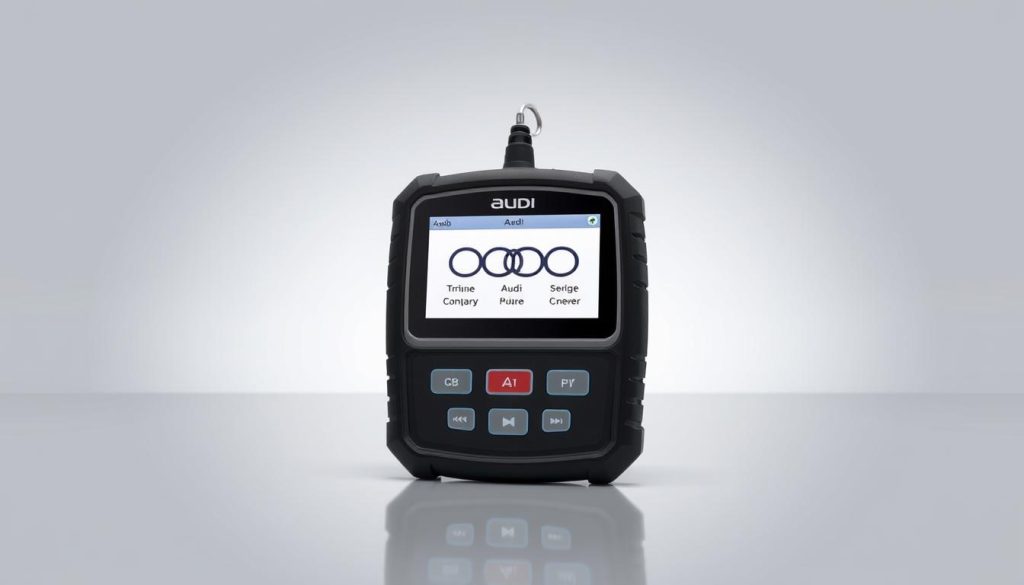Experiencing a transmission fault in your Audi can be concerning, as it may lead to slipping gears, unusual noises, and other issues that affect your vehicle’s performance. Promptly addressing these problems is crucial to prevent further damage and costly repairs. This guide will walk you through the steps to diagnose and repair common Audi transmission issues, ensuring your vehicle runs smoothly.
Understanding the symptoms of a malfunctioning transmission, such as delayed or rough shifting and warning lights on the dashboard, is key to identifying the problem. You can start by checking the transmission fluid level and condition, as low or dirty fluid can cause issues. For more complex problems, resetting the Transmission Control Module (TCM) or updating its software may be necessary. In some cases, parts like transmission solenoids or the torque converter may need replacement.
Key Takeaways
- Check transmission fluid level and condition regularly.
- Understand the symptoms of transmission faults, such as slipping gears and unusual noises.
- Reset the Transmission Control Module (TCM) for minor issues.
- Update the TCM software to the latest firmware.
- Replace faulty transmission parts, such as solenoids or the torque converter, as needed.
Understanding Audi Transmission Systems
Audi transmissions come in several varieties, including automatic, DSG, and CVT, each designed to cater to different driving needs. Understanding these transmission types is crucial for diagnosing and repairing potential issues.
Types of Audi Transmissions (Automatic, DSG, CVT)
Audi offers a range of transmissions, including:
- Automatic Transmission: Provides smooth shifting and is suitable for various driving conditions.
- DSG (Direct Shift Gearbox): A dual-clutch transmission that offers quick gear changes and is known for its sporty driving experience.
- CVT (Continuously Variable Transmission): Offers infinite gear ratios within a certain range, providing optimal engine performance and fuel efficiency.
Each transmission type has its advantages and is suited for different Audi models and driving preferences.
How Audi Transmissions Function
Audi transmissions function by transferring power from the engine to the wheels, using various mechanical and hydraulic components. The transmission control module (TCM) plays a crucial role in managing gear shifts, ensuring smooth acceleration and optimal performance.
Identifying Your Specific Transmission Model
To identify your Audi’s transmission model, you can check the vehicle’s documentation or look for a placard on the transmission itself. Knowing your transmission type is essential for proper maintenance, diagnosis, and repair.
Some common ways to identify the transmission include:
- Checking the vehicle’s owner’s manual.
- Looking for a label or placard on the transmission.
- Using a VIN decoder or consulting with an Audi dealership.
Identifying Common Audi Transmission Fault Symptoms
Recognizing the signs of transmission problems in your Audi is crucial for preventing further damage. Transmission faults can lead to significant repair costs if not addressed promptly.
Dashboard Warning Lights and Error Messages
One of the first indicators of a transmission issue is the illumination of warning lights on your dashboard. Audi vehicles are equipped with sophisticated diagnostic systems that can detect transmission problems and alert you through specific warning lights or error messages on the instrument cluster. For instance, the “Transmission Fault” warning light may appear, signaling that there’s an issue that requires immediate attention. Understanding what these Audi dashboard symbols mean can help you diagnose the problem more effectively.
Performance Issues (Delayed Shifting, Jerking, Slipping)
Performance issues are another common symptom of transmission faults. If your Audi experiences delayed shifting, jerking, or slipping between gears, it could be a sign of a transmission problem. Delayed shifting might occur when the transmission hesitates before engaging a gear, while jerking or slipping can feel like a sudden, brief loss of power or a “slip” before the transmission regains traction. These symptoms can be particularly noticeable during acceleration or when driving uphill.
Unusual Sounds and Physical Symptoms
Unusual sounds emanating from the transmission area, such as grinding, whining, or clunking noises, can also indicate a problem. Additionally, physical symptoms like vibrations or shaking when driving can be related to transmission issues. These symptoms suggest that there might be mechanical wear or damage within the transmission.
Fluid Leaks and Burning Odors
Transmission fluid leaks are a serious issue that can lead to transmission failure if not addressed. If you notice red or brown fluid leaking from your Audi, it could be transmission fluid. Additionally, a burning odor, especially one that intensifies when driving, can be a sign of overheating transmission fluid or other transmission-related problems. Both of these symptoms require immediate inspection and repair.
By being aware of these common symptoms, Audi owners can take proactive steps to diagnose and repair transmission faults, potentially avoiding more costly repairs down the line.
Essential Tools and Safety Precautions
Proper preparation is essential when working on Audi transmissions, including having the right tools and safety measures in place. To ensure a safe and efficient repair process, it’s crucial to understand the necessary diagnostic equipment and safety precautions.
Required Diagnostic Equipment
For accurate diagnosis, you’ll need an OBD scanner specifically designed for Audi. This equipment allows you to read transmission error codes and monitor the transmission’s performance. Popular OBD scanners for Audi include those from Carista and VCDS.

Necessary Hand Tools and Supplies
In addition to diagnostic equipment, you’ll need a set of basic hand tools, including socket sets, Torx drivers, and pliers. It’s also essential to have transmission-specific tools, such as a transmission filter wrench and fluid pump. Make sure to have a clean workspace and necessary supplies, like rags and cleaning solution.
Safety Measures When Working with Transmissions
Safety should be your top priority when working with transmissions. Always wear protective gear, including gloves and safety glasses. Be cautious when handling electrical components and avoid short circuits. Ensure the vehicle is securely supported on jack stands and apply the parking brake.
Workshop Preparation Tips
Before starting the repair, prepare your workspace by clearing clutter and organizing your tools. Ensure good ventilation and have a fire extinguisher nearby. It’s also a good idea to consult your workshop manual for specific safety precautions and guidelines for your particular Audi model.
Diagnosing and Troubleshooting Audi Transmission Fault
Effective diagnosis of Audi transmission faults requires a combination of technical knowledge and the right diagnostic equipment. This section will guide you through the process of diagnosing and troubleshooting common transmission issues in your Audi vehicle.
Connecting and Using OBD Scanners
The first step in diagnosing an Audi transmission fault is to use an OBD (On-Board Diagnostics) scanner. This tool connects to your vehicle’s OBD port and retrieves error codes stored in the transmission control module. To get started, you’ll need an OBD scanner compatible with Audi vehicles, such as those that support OBD-II protocols.
Once connected, the scanner will display a list of error codes specific to your Audi’s transmission system. These codes provide valuable information about the nature of the fault.

Interpreting Transmission Error Codes
Interpreting the error codes retrieved by the OBD scanner is crucial for diagnosing the transmission fault. Audi transmission error codes typically start with a letter followed by a series of numbers. You can find the meaning of these codes in your vehicle’s repair manual or online databases.
Some common transmission error codes for Audi include those related to solenoid malfunctions, transmission fluid temperature issues, and gear ratio problems.
Checking Transmission Fluid Level and Condition
After interpreting the error codes, the next step is to check the transmission fluid level and condition. Low fluid levels or contaminated fluid can cause a range of transmission problems. To check the fluid, locate the transmission dipstick, pull it out, and wipe it clean. Insert it back into the transmission and pull it out again to get an accurate reading.
- Check the fluid level against the recommended level in your owner’s manual.
- Inspect the fluid’s color and consistency; it should be pink or red and not smell burnt.
Mechanical Inspection Procedures
A mechanical inspection is necessary to identify any physical issues with the transmission. This may involve checking for signs of leaks, inspecting the transmission mounts, and examining the condition of the transmission pan and filter.
Some common signs of mechanical issues include unusual noises, vibrations, or visible leaks under the vehicle.
Determining Repair Complexity and Cost Estimates
Once you’ve diagnosed the transmission fault, you’ll need to determine the complexity of the repair and estimate the costs involved. This will help you decide whether to proceed with the repair yourself or seek professional assistance.
Consider factors such as the cost of replacement parts, labor costs, and the potential for additional repairs.
Key considerations for cost estimates include:
- The cost of replacement parts, such as solenoids, sensors, or transmission fluid.
- Labor costs, which can vary depending on the complexity of the repair and the mechanic’s rates.
- The potential for additional repairs, such as replacing the transmission filter or mechatronic unit.
Step-by-Step Repair Procedures
The key to successful Audi transmission repair lies in identifying the problem accurately and following the appropriate repair procedures. This involves a series of steps that, when followed correctly, can help resolve common transmission issues.
Transmission Fluid and Filter Replacement
One of the most common maintenance tasks for Audi transmissions is transmission fluid replacement. Over time, the fluid can degrade, losing its lubricating properties and potentially causing damage to the transmission. Replacing the fluid and filter can help maintain the transmission’s performance and longevity. It’s essential to use the correct type of fluid as specified by Audi to ensure compatibility.
To replace the transmission fluid and filter, start by locating the drain plug or pan. Be prepared to catch the fluid as it drains out. Once drained, replace the filter and refill with the new fluid. It’s crucial to check for any leaks after refilling.
Resetting Transmission Control Module Adaptations
Sometimes, the Transmission Control Module (TCM) needs to be reset, especially after repairs or maintenance. This process involves using a diagnostic tool to communicate with the TCM and reset its adaptations. The TCM adapts to the driver’s behavior and the transmission’s condition over time, so resetting it can help resolve issues related to shifting or performance.
For detailed instructions on resetting the TCM, refer to the repair manual or a professional diagnostic guide. It’s a process that requires careful attention to detail to avoid causing further issues.
Replacing Solenoids and Sensors
Solenoid replacement is another common repair task. Solenoids control the flow of fluid within the transmission, and faulty solenoids can cause shifting problems or other issues. Identifying the correct solenoid to replace requires diagnostic testing, often using an OBD-II scanner to read trouble codes, such as the P2704 OBD-II trouble code, which relates to transmission friction element E apply time range performance.
Replacing solenoids involves accessing the transmission’s solenoid pack, removing the faulty solenoid, and installing a new one. It’s a task that requires patience and attention to detail.
Mechatronic Unit Repair or Replacement
The mechatronic unit is a critical component of modern Audi transmissions, responsible for controlling the transmission’s functions. Repairing or replacing this unit can be complex and may require specialized tools and expertise. In some cases, it may be more cost-effective to replace the unit entirely, especially if it’s severely damaged.
When to Consider Professional Repair Services
While many Audi transmission repairs can be done DIY, there are times when it’s best to seek professional repair services. If the repair involves complex components like the mechatronic unit or requires specialized diagnostic equipment, it’s advisable to consult a professional mechanic. They have the necessary experience and tools to ensure the repair is done correctly and safely.
Conclusion
Regular Audi transmission maintenance is crucial for preventing transmission faults and ensuring your vehicle runs smoothly. By following the steps outlined in this guide, you can identify potential issues early and take corrective action to avoid costly repairs.
Proper transmission maintenance involves checking transmission fluid levels, replacing filters, and resetting the transmission control module adaptations as needed. By staying on top of these tasks, you can significantly reduce the risk of transmission fault and prolong the lifespan of your Audi’s transmission.
Effective transmission fault prevention requires a proactive approach. By understanding the common symptoms of transmission faults and taking prompt action when issues arise, you can keep your Audi vehicle in optimal condition and avoid more extensive repairs down the line.
FAQ
What are the common signs of Audi transmission failure?
Common signs include dashboard warning lights, delayed shifting, jerking, slipping, unusual sounds, fluid leaks, and burning odors.
How do I identify the type of transmission in my Audi?
Check your vehicle’s documentation or consult with a dealership or mechanic to determine if your Audi has an automatic, DSG, or CVT transmission.
Can I diagnose Audi transmission faults myself?
Yes, using an OBD scanner and following diagnostic procedures can help identify transmission issues, but complex problems may require professional assistance.
What is the importance of checking transmission fluid level and condition?
Regular checks can help prevent damage by identifying leaks, contamination, or degradation of the fluid, which can lead to transmission failure.
How do I reset the transmission control module adaptations?
This typically involves using a diagnostic tool to clear adaptations and allow the module to relearn the transmission’s operating parameters.
When should I consider seeking professional repair services for my Audi transmission?
If you’re unsure about the diagnosis, the repair is complex, or you’re not comfortable with DIY repairs, it’s recommended to seek professional assistance.
What is the role of the mechatronic unit in Audi transmissions?
The mechatronic unit controls the transmission’s functions, including gear shifting and pressure regulation, and its failure can lead to significant transmission problems.
Can replacing transmission fluid and filter resolve transmission issues?
In some cases, yes, but if the problem persists, further diagnosis and repair may be necessary to address underlying issues.
How often should I replace the transmission fluid in my Audi?
Consult your owner’s manual or manufacturer’s recommendations for the recommended interval, as it varies depending on the transmission type and model year.
What are the benefits of using genuine Audi parts for transmission repairs?
Genuine parts ensure compatibility, quality, and reliability, reducing the risk of further damage or premature wear.


